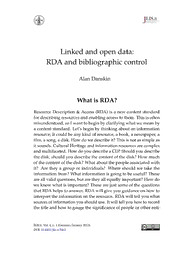Table Of ContentLinked and open data:
RDA and bibliographic control
AlanDanskin
What is RDA?
Resource Description & Access (RDA) is a new content standard
fordescribingresourcesandenablingaccesstothem. Thisisoften
misunderstood,soIwanttobeginbyclarifyingwhatwemeanby
acontentstandard. Let’sbeginbythinkingaboutaninformation
resource;itcouldbeanykindofresource,abook,anewspaper,a
film,asong,adisk. Howdowedescribeit? Thisisnotassimpleas
itsounds. CulturalHeritageandinformationresourcesarecomplex
andmultifaceted. HowdoyoudescribeaCD?Shouldyoudescribe
thedisk,shouldyoudescribethecontentofthedisk? Howmuch
ofthecontentofthedisk? Whataboutthepeopleassociatedwith
it? Are they a group or individuals? Where should we take the
informationfrom? Whatinformationisgoingtobeuseful? These
areallvalidquestions,butaretheyallequallyimportant? Howdo
weknowwhatisimportant? Thesearejustsomeofthequestions
thatRDAhelpstoanswer. RDAwillgiveyouguidanceonhowto
interprettheinformationontheresource. RDAwilltellyouwhat
sourcesofinformationyoushoulduse. Itwilltellyouhowtorecord
thetitleandhowtogaugethesignificanceofpeopleorotherenti-
JLIS.it.Vol.4,n.1(Gennaio/January2013).
DOI:10.4403/jlis.it-5463
A.Danskin,Linkedandopendata...
tiesassociatedwiththeresource. RDAisthelatestmanifestation
ofacataloguingtraditionthatwasdevelopedinthe19thcentury.
Fromacataloguer’sperspective,RDAhastodothesamethingsthat
theAnglo-AmericanCataloguingRules,2ndedition(AACR2)have
done for the last forty years, but the rapidly changing technolog-
icalenvironmentinwhichRDAhasdevelopedcreatesadditional
demands.
RDAisdifferentfromitspredecessors,includingAnglo-American
CataloguingRules,whichoriginatedinanerawhenprintwasthe
dominantmeansofcommunication. RDAisoneofthefirstgeneral
cataloguing codes to be created since digital began to supplant
printasthedominanttechnologyforcommunication. Thenegative
reactionsthatgreetedthedraftsofRDAandwhichcontinuetobe
repeatedcanbeattributedinparttothefactthatRDAinstructions
andguidelineslookverysimilartoAACR2.Manyprospectiveusers
are disappointed because they feel that such a big technological
changedemandsanequallybigresponseintheinstructions; and
for some it calls into question the need for RDA at all. If there is
relativelylittlechangeinRDA,whatisthejustificationforadopting
anewstandard?
Justification and criticism
TheoriginaljustificationforRDAcamefromtheconferenceonthe
futureofAACR2,heldinTorontoin1997. Theconferenceidentified
structuralissueswithAACR2whichweretoodeeplyrootedtobe
correctedthroughthenormalrevisionprocess. Theseincludedthe
confusionofcontentwithcarrier;arrangementbyclassofmateri-
als and the cultural bias of many instructions. Initial attempts to
addresstheseproblemsthroughaneweditionofAnglo-American
CataloguingRules(AACR)didnotgofarenoughandRDAdevel-
JLIS.it. Vol.4,n.1(Gennaio/January2013).Art.#5463 p.148
JLIS.it.Vol.4,n.1(Gennaio/January2013)
opedfromtherealisationthatanewstandardwasneedtoaddress
theseissues.
ResponsestotheinitialdraftsofRDAweremixed.Thereweremany
whofeltthatAACR2wasn’tbrokenanddidn’tneedtobefixed,but
therewerealsomanyrespondentswhoarguedthatRDAdidnotgo
farenough. Frequentcriticismswere:
• RDAshouldbeanopenstandard;
• RDAshouldbelesslikeacataloguingcodeandmorelikea
datadictionary;
• RDAshouldbemoreexplicitlystructuredaroundFunctional
RequirementsforBibliographicRecords(FRBR).
JointSteeringCommittee(JSC)tooktheseconcernsseriouslyandhas
addressedthem.TheseissueshaveabearingonRDA’scompatibility
withlinkeddata.
Open standard
RDAisanopenstandardinthesensetheanyinterestedpartycan
contributetoitsdevelopment. Editorialcontroloverthestandard
resideswiththeJointSteeringCommitteeforDevelopmentofRDA.
JSCismadeupofrepresentativesofthosecommunitiesalreadycom-
mittedtoRDA: theAustralianCommitteeonCataloguing(ACOC);
theAmericanLibraryAssociation(ALA);BritishLibrary(BL);Cana-
dianCataloguingCommittee(CCC),CharteredInstituteofLibrary
andInformationProfessionals(CILIP)andLibraryofCongress(LC).
InJanuary2012,theDeutscheNationalbliothek(DNB)becamethe
mostrecentmember. Butyoudon’thavetobeamemberofJSCor
oneofitsconstituenciestocontributetoRDAdevelopment. Any
organizationorindividualcansuggestchangesdirectlytotheChair
JLIS.it. Vol.4,n.1(Gennaio/January2013).Art.#5463 p.149
A.Danskin,Linkedandopendata...
ofJSC. InEurope,EURIG(EuropeanRDAInterestGroup)offersan
informalforumfordiscussionandcollaboration.
RDAisopenbutnotfree. RDAdevelopmentispaidforbycharging
foraccesstothestandard. Thisisacommonmodelforstandards
anditisfairinthesensethatdevelopmentispaidforbyusers. RDA
hastobesustainableinthelongtermandnochangetothebusiness
modelcanbeconsidereduntiltheinvestmenthasbeenrecouped.
It isrecognised thatnot every userof RDA requiresaccess to the
instructions;thereforesomecontentisbeingmadefreelyavailable
as Linked Open Data. The Committee of Principals agreed that
theRDAelementsetandtheRDAvocabulariesshouldbeplaced
in the public domain to enable their re-use. The element set and
theRDAvocabulariesarebeingpublishedintheOpenMetadata
Registry(OMR).1
Element set and metadata
RDAwasdevelopedtobeindependentofanyspecificschemaor
format.2 RDA conforms to broad principles of good metadata3
practice. RDAisbasedonIFLA’sFRfamilyofmodels,whichdefine
theentitiesorobjectsofinterestspecifiedinRDA. TheRDAelement
setcorrespondstotheattributesandrelationshipsdefinedforthose
entities.
RDAgivesdefinitionsforeachelementandspecifieshowthecon-
tent(orvaluerepresentations)oftheelementshouldberecorded.
1OpenMetadataRegistryhttp://metadataregistry.org/,RDAnamespacehttp:
//rdvocab.info/.
2JSC.StatementofobjectivesandprinciplesforRDA.1July2009.5JSC/RDA/Ob-
jectivesandPrinciples/Rev/3
http://www.RDA-jsc.org/docs/5rda-objectivesrev3.pdf.
3JSCEncodingRDAdata. 31May20075JSC/Editor/3,http://www.RDA-jsc.
org/docs/5editor3.pdf.
JLIS.it. Vol.4,n.1(Gennaio/January2013).Art.#5463 p.150
JLIS.it.Vol.4,n.1(Gennaio/January2013)
RDA also incorporates some features of an application profile by
specifyingwhetheranelementisconsideredtobecoreornon-core.
An element is considered to be core if it is required to support a
basic user task. Some elements are considered to be core only in
particularcircumstancesorforparticulartypesofresource.
RDAalsospecifiescontrolledlistsofvaluesorvocabularies,which
aremostlyopenallowingnewtermstobeaddedtomeetchanging
needs. A few vocabularies, such as the RDA/ONIX Framework
forResourceCategorization(ROF),areclosed. ROFwasdeveloped
inconjunctionwithEditeurtoprovideaflexible, extensivesetof
attributesandvaluestodescribeboththeintellectualcontentofa
resourceandthecharacteristicsofitscarrier(Dunsire,“Distinguish-
ingContentfromcarrier: theRDA/ONIXFrameworkforResource
Categorization”).4
FRBR and Functional Requirements for
Autority Data (FRAD)
RDAisanimplementationoftwomodels: FunctionalRequirements
forBibliographicRecordsandtheFunctionalRequirementsforAu-
thorityData(IFLAStudyGroupontheFunctionalRequirements
forBibliographicRecords,FunctionalRequirementsforBibliographic
Records: Final Report). RDA does not specifically implement the
FunctionalRequirementsforSubjectAuthorityData(IFLAWorking
GrouponFunctionalRequirementsandNumberingofAuthority
Records(FRANAR),FunctionalRequirementsforAuthorityData: A
ConceptualModel),whichwasdevelopedtoolateforinclusion. In
responsetocriticisms(basedonearlydrafts)thatRDAwasnotsuf-
4RDA/ONIXFrameworkforResourceCategorization,version1.0(Released1
August2006).5JSC/Chair/10,http://www.RDA-jsc.org/working2.html#chair-10.
JLIS.it. Vol.4,n.1(Gennaio/January2013).Art.#5463 p.151
A.Danskin,Linkedandopendata...
ficiently“FRBRised”,JSCcomprehensivelyrevisedthestructureto
relatethesequencetotheFRBRandFRADmodels.5
FewcurrentcataloguingsystemsorschemausetheFRBRorFRAD
models. Threepossibleimplementationscenarioswereidentified
formigrationtoRDA:6
• scenario1: fullyrelationalorobjectorienteddatabasestruc-
ture;
• scenario 2: Integrated Library System (ILS) structure, with
separatebibliographic,authorityandholdingsrecords;
• scenario3: flatfilestructureinwhichthebibliographicrecord
isthevehicleforallthemetadata.
Tosupportmigrationfromscenarios2and3,RDAincludesfeatures
which are rightly regarded as out of place in a modern metadata
standard. Forexample,RDAprovidesdetailedinstructionsonhow
tobuildauthorizedaccesspointsbystringingmetadataattributes
togetherintoauniquekey. Forexample,theauthorisedaccesspoint
fortheworkBleakHousewouldbe:
Dickens,Charles,1812-1870.BleakHouse
TheauthorisedaccesspointforaFrenchtranslationwouldbe:
Dickens,Charles,1812-1870.BleakHouse.French
This is the kind of data currently required by some systems. In
a relational database system the string would be replaced by an
identifierrepresentinganauthorityrecordforthework;inalinked
datacontextthedifferentcomponentsandtherelationshipsbetween
themwouldberepresentedbyURIs.
5JSCRDAScopeandStructure. 1July2009. 5JSC/RDA/Scope/Rev/4, http:
//www.RDA-jsc.org/docs/5rda-scoperev4.pdf.
6JSCRDA,FRBR/FRADImplementationscenarios.23January2008.5JSC/Edi-
tor/4,http://www.rda-jsc.org/docs/5editor4.pdf.
JLIS.it. Vol.4,n.1(Gennaio/January2013).Art.#5463 p.152
JLIS.it.Vol.4,n.1(Gennaio/January2013)
RDA as linked data
RDAwasoriginallyconceivedofatalessgranularlevelthanRe-
source Description Framework (RDF) properties, but that is not
a barrier to its use in a linked data context. Meaningful linking
betweenresourcesisinherentinRDA.
RDAAppendixJdefinesrelationshipdesignatorstoenableconsis-
tentandexplicitlinkingbetweenbibliographicresources. Drawing
uponTillett’staxonomyofbibliographicrelationships,RDAmakes
itpossibletoexpressderivative,descriptive,whole-part,accompa-
nying, equivalent or sequential relationships (Tillett); refinement
oftermsenablesnuancesoftherelationshiptobeexpressed. For
example, The bored of the rings is a derivative work, which is an
imitation of, or more explicitly, a parody of, The lord of the rings.
Approximately200bibliographicrelationshipsarespecifiedinRDA.
RDA Appendix I defines relationship designators to connect re-
sources to persons, families, or corporate bodies. For example
Charles Dickens is the author of the work Bleak house; Andrew
Daviesisthescreenwriterofthe2005workBleakHouse.
TherelationshipdesignatorsspecifiedinappendicesIandJhave
beenregisteredontheOpenMetadataRegistry. SeventyfiveRDA
vocabularieshavealsobeenregisteredintheOMR. Thevocabular-
iesconstitutearichsourceofmetadata,withapplicationsbeyond
libraries. ThevocabulariesrangefromAppliedmaterialtoVideo
Format and encompass terms as diverse as spoken word: (Con-
tenttype),quarterly(Frequency);female(Gender);serial(Modeof
issuance). Atotalof810termshavebeenregisteredinvocabularies.
RDAvocabularieshavegreatpotentialforreuse. Therelationship
designatorsareparticularlyvaluableforexplainingwhyxisrelated
to y, but it is important to be aware that they are not yet stable.
ThemajorityofRDAtermsinOMRcurrentlyhavethestatus“New
Proposed”. JSC,withtheassistanceofMetadataManagementAsso-
JLIS.it. Vol.4,n.1(Gennaio/January2013).Art.#5463 p.153
A.Danskin,Linkedandopendata...
ciates,isintheprocessofchangingthestatusto“published”.
Atpresent,onlyarelativelysmallnumberofvocabularieshave
beenpublishedbecauseJSCisconfirmingdefinitionsforallofthe
terms. This process has inevitably raised some issues regarding
duplicationoftermsbetweenvocabulariesandtheformsofterms.
JSCintendstoresolvetheseissuesbeforepublishingtheterms. Pub-
licationofthetermsintheOMRsignalstothecommunitythatthe
URIs forthe conceptrepresentedby the termcan bereusedwith
confidence. The RDA elements are also registered on OMR with
thestatusof“New-Proposed”. JSCisreviewingtheRDAelement
setbasedonfeedbackfromtestingandextensivediscussionswith
MetadataManagementAssociates(MMA). JSChastobeconfident
thattheelementsetisstablebeforetheelementsarepublished. Sev-
eraldifficultissues havehadtoberesolvedinorder toattainthe
requiredlevelofconfidence.
Constrained or unconstrained elements
Anaspectofthelinkeddatavisionisthatmetadatacanbreakdown
barriers,includingthosesiloserectedwithintheculturalheritage
sectortomeetthespecificneedsofmuseums,archivesandlibraries.
Placingconstraintsonlinkedmetadataelementsisabarriertoreuse.
Forexample,RDAPublisher’sNameisanRDFpropertywithdo-
main manifestation. This is consistent with the FRBR model but
it makes the element unattractive to users or communities who
do not perceive a need to distinguish between Work, Expression
ManifestationandItem. IthastakensometimeforJSCtounder-
standtheseperspectivesandfromJSC’sperspectiveanelementset
withoutFRBRcannotbeRDA.Itwasthereforeagreedthatanuncon-
strained(orunbound)elementsetshouldbecreatedinadditionto
theconstrainedelements. Asillustratedbelow,theconstrainedRDA
JLIS.it. Vol.4,n.1(Gennaio/January2013).Art.#5463 p.154
JLIS.it.Vol.4,n.1(Gennaio/January2013)
elementshavebeenmodeledassub-propertiesoftheunconstrained
elements. Inthisexampletheconstrainedelementiscurrentlydis-
tinguishedbyaparentheticalqualifierinthelabel. Publisher’sname
(Manifestation)hasdomainManifestation,asisreflectedintheURI.
TheunconstrainedelementPublisher’sNameisthe“parent”ofthe
constrainedelement,“Publisher’sname(Manifestation),butitsown
domainisunbounded. Theregistrationofconstrainedanduncon-
strainedelementsinthesamenamespaceislikelytobeconfusingto
prospectiveusersandwillalsocomplicatedisseminationofinfor-
mationabouttheelementsets. Differentoptionsforresolvingthese
problemsarebeingdiscussedbythestakeholdersandneedtobe
resolvedbeforetheelementscanbepublished.
TheRDAnamespacealsoincludesFRBRentitiesforRDAelement
set. ThiselementsetwasregisteredbecauseFRBRandFRADenti-
tieswererequiredbyRDAbuthadnotbeenregisteredbyIFLA.
Interoperability and mapping
In addition to FRBR and RDA, the International Standard Biblio-
graphicDescriptionelementsetwaspublishedontheOMRin2011;
basicMARC21elementshavealsobeenpublishedandtheDublin
Core Element set has been available since 2008. The increasing
availability of element sets and vocabularies in RDF creates new
possibilitiesforinteroperabilityandmapping. AttheJSCmeeting
in Glasgow, in 2011, Gordon Dunsire reported on work to map
betweentheRDAandInternationalStandardBibliographicDescrip-
tion(ISBD)elementsetsandvocabularies(Dunsire,“MappingISBD
andRDAelementsets: briefing/discussionpaper”;“MappingISBD
Area 0 vocabularies to RDA carrier and content”). Two different
approacheswerefollowed.
TheISBDArea0vocabulariesandtheRDAvocabulariesforcontent
JLIS.it. Vol.4,n.1(Gennaio/January2013).Art.#5463 p.155
A.Danskin,Linkedandopendata...
type,mediatypeandcarriertypeweremappedinahubandspoke
modeltotheRDA/ONIXFrameworkforResourceCategorization.
The ISBD and RDA element sets were mapped using the ele-
mentdefinitionsandscopenotesandthemoreexplicitsemantics
inpropertyandclassdeclarations. TheexerciseimpliedthatRDA
and ISBD elements are sub-properties of other properties, which
haveneitherISBDnorRDAasdomainsorranges. Toputitanother
way,unconstrainedorunboundedelementscouldsupportmapping
betweentheconstrainedISBDandRDAelementsets.
At the DCMIUK Regional Meetinghosted by the British Library
inApril,2012Dunsireexploredtheseideasfurther,usingMARC
21andDublinCore. Asignificantimplicationofthisworkisthat
itispossibletobuildmappingsbetweenelementsetswhichhave
differentlevelsofspecificity. ThereforeitispossibletolinkMARC
21”Targetaudience“; DublinCoreTerms”audience“; FRBR”has
intended audience“; and RDA ”intended audience“ by means of
anunconstrainedproperty”intendedaudience“,whichcanitself
be link to ISBD ”has note on use or audience“ through a further
unconstrainedproperty,”hasnoteonuseoraudience. RichRDA
metadata linked as sub-properties of less granular elements can
bedumbed-upintosimpleDublinCoreforapplicationsthatdon’t
wantRDA(“TurtleDreaming”).
Similarapproachescouldbefollowedforothermetadataschema
with wider application than libraries. There is much common
groundbetweenRDAandFriendofaFriend(FOAF);bothdefine
propertiesoftheperson. TheregistrationofRDApropertiesinRDF
willenableamorerigorouscomparisonoftheirsemanticsandhow
and whether they relate will become clearer. For example, RDA
doesnotrefinethecomponentsofapersonalname,butFOAFdoes
havepropertiesforgivennameandfamilyname.
JLIS.it. Vol.4,n.1(Gennaio/January2013).Art.#5463 p.156

